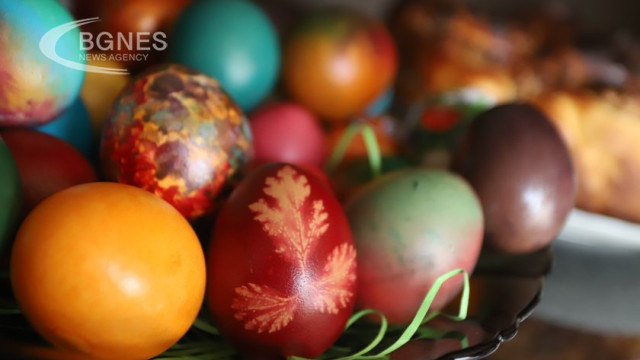Easter eggs are painted on Maundy Thursday. The first egg should be red. With it, the sign of the cross is made on the foreheads of the children, and then on all the rest of the family. It is put aside from the others and replaced with last year's, which all along stayed in the house - to bring health, joy and happiness to its inhabitants.
The egg is kept somewhere in a display case so that it does not break and brings good luck. The next egg is also red - it is left in the church on Saturday evening, after the festive liturgy, which continues after midnight, or the next day.
On Maundy Thursday, the leaven is renewed and the dough for the Easter bread is kneaded. They bear the most diverse names in Bulgaria: 'Easter kravai', 'God's pita', 'Koshara', Harrow, 'Kvasnik', Egg, 'Plenitsa' or Doll. They are usually decorated with an odd number of red or white eggs and dough twisted around them. Women also prepare smaller Easter breads with a red egg in the middle, which are given to the first guest, the best men, and relatives.
There are countless techniques for dyeing Easter eggs, but one of the most popular in our latitudes is dyeing eggs with wax. This technique is one of the old traditional techniques known in our country. It is one of the most interesting and with the richest possibilities for painting and decorating Easter eggs. Determining the technique is the use of melted pure beeswax to write the drawing with the help of a special device pen. The main material in this technique can only be pure beeswax, which can be found by beekeepers in the market. It is important to note that paraffin or other synthetic substances, even church candles, cannot be used for painting, as they spill during painting and do not have the necessary qualities. Pure beeswax is honey-yellow in colour. Its preparation for work involves melting it in a shallow container, straining it to remove possible impurities (dust or particles), and cutting it while still warm into small thin strips or wicks, convenient to put in the pen funnel.
The wax can be kept constantly melted in a shallow pot on the fire during work, without "frying", smoking and burning. To obtain the black contours of the drawing, the wax can be coloured black according to traditional practice with pine tar or soot. These procedures can be replaced by colouring the wax with oil painting paint. The similarity in the chemical composition of oil paint and wax allows for a homogeneous mixture. In addition to black, the wax can be coloured white, yellow, red, brown, ocher, green, etc. In the Bulgarian folk tradition, the main tool for writing with wax is the pen. The pen is dipped in a container of melted wax and "written" on the egg with it. In addition to a pen, a needle, broomstick, straw or feather can be used.
The question of the origin of the Easter egg is still a mystery to historians and ethnologists. The most recent evidence suggests that the first dyed eggs date back to 2000 BC. These are ostrich, with an engraved ornament, and were found in Egypt. Their symbolism is again related to the Resurrection and the afterlife. This leads scholars to believe that the painting tradition dates back to prehistoric times, but with the establishment of Christianity, the details were attached to the life and Resurrection of Jesus.
The first decorated egg found on our lands dates back to the Roman era or IV-III centuries before the New Era, decorated with coloured glass enamels. Painted eggs were also found in 11th-12th century burials in the lands of the Western Slavic peoples.
Despite the historical disputes about the beginning of the tradition, one thing is certain - each coloured egg symbolizes resurrection, life and love, and according to the inscription, it also carries a message of health, longevity, luck and prosperity. /BGNES







